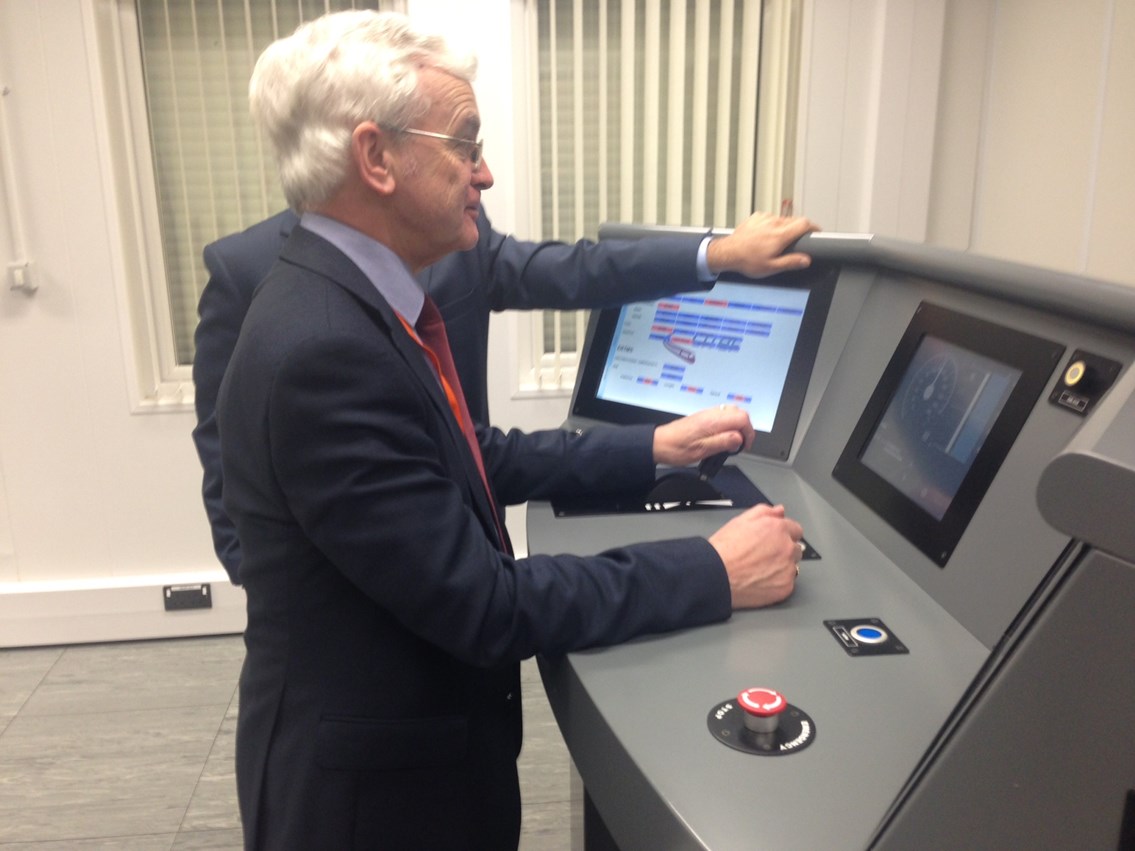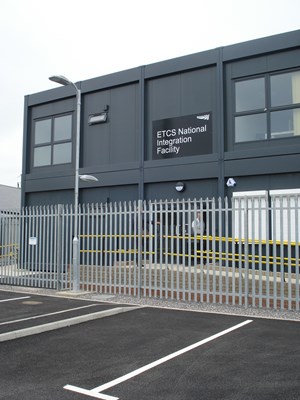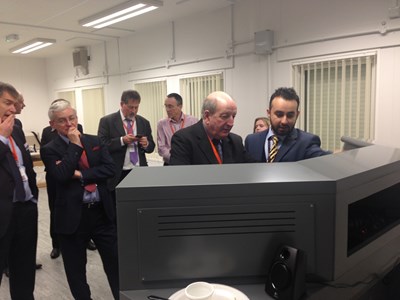Tuesday 2 Feb 2016
Parliamentary visit to European Train Control System test centre
- Region & Route:
- National
Senior members of the All Party Parliamentary Rail Group (APPG) visited the ETCS (European Train Control System) National Integration Facility (ENIF) to learn about Network Rail’s Digital Railway Programme and test Hitachi’s ETCS driving simulator.
Lord Berkeley and Martin Vickers MP, Secretary and Chair of the APPG, were given an overview of the signalling modernisation programme last Tuesday (27 January), which forms a key part of Network Rail’s blueprint for the railway of the future. Senior members of the Digital Railway Programme outlined the principle technologies involved and the working timetable for deployment, and were joined by representatives from development partners Siemens, Hitachi and Signalling Solutions Ltd.
After a technical briefing both parliamentarians accepted an invitation to use Hitachi’s ETCS driving simulator to experience first-hand how trains will be operated in future.
ETCS is the signalling component of the European Rail Traffic Management System (ERTMS) and will underpin the digital modernisation of signalling on the network. Driving simulators are used to train drivers on ETCS which provides a target speed, including movement authority, on a screen in the cab. The train ‘knows’ where it is through a combination of trackside equipment and on-board sensors, while instructions from the control centre are conveyed through the GSM-R (Global System for Mobile – Railway) signal.
The ETCS National Integration Facility at Hitchin utilises a five-mile stretch of railway on the Hertford Loop between Molewood Tunnel and Langley South junction, controlled from a new structure in the former Hitchin goods yard. The test facility is being used by Network Rail to examine suppliers’ trackside ETCS equipment, using a converted Class 313 laboratory train.
By signalling each train according to its braking and accelerating capabilities, ETCS will release much needed capacity from the current network, and also deliver considerable cost savings over traditional lineside maintenance and renewal programmes. ETCS is an important part of Network Rail’s digital modernisation programme, which will combine hundreds of signalling locations into 12 Rail Operating Centres (ROCs), using traffic management software to control the flow of trains.
The visit was hosted by Jerry England, group Digital Railway director at Network Rail, who said: “Modernising the network is vital if we are to meet the rising demand that will add another one billion rail journeys a year by 2032. We were delighted that two senior parliamentarians with a deep interest in the railway network found time to learn about the benefits of digital technology for both passengers and industry.”
The Digital Railway programme is a cross industry initiative that will modernise the rail network with digital technology to improve capacity, connectivity, and reliability. Our current railway relies on a signalling system that is outdated and costly to maintain. Great Britain needs an efficient railway that supports economic growth in every region by connecting more people and goods to more places and with reduced end-to-end journey times – that is the Digital Railway.
Lord Berkeley, a rail expert, and a former civil engineer said: “Modernising our railways with digital technology will release desperately needed capacity on the network and improve connectivity and reliability. It was greatly encouraging to learn more about Network Rail’s plans and how they are working closely with companies like Siemens, Hitachi, and SSL to develop, test and deploy advanced technology for the benefit of passengers and industry. This is the best solution to release capacity where it is needed and I look forward to the start of the roll-out of this comprehensive package in the next Control Period”.
With the railway already operating at full capacity on some major routes, and with demand forecast to double in the next 25 years, Britain needs a strategy to unlock capacity from the existing network. The Digital Railway programme is a cross industry initiative that will modernise the rail network with digital technology to improve capacity, connectivity, and reliability. It will provide the modern railway with improved connectivity that is essential to a successful, higher wage, economy for Britain.
Contact information
Passengers / community members
Network Rail national helpline
03457 11 41 41
Latest travel advice
Please visit National Rail Enquiries
Journalists
Network Rail press office -Dan Donovan
Media Relations Manager
020 3356 8700
Dan.Donovan@networkrail.co.uk
About Network Rail
We own, operate and develop Britain's railway infrastructure; that's 20,000 miles of track, 30,000 bridges, tunnels and viaducts and the thousands of signals, level crossings and stations. We run 20 of the UK's largest stations while all the others, over 2,500, are run by the country's train operating companies.
Usually, there are almost five million journeys made in the UK and over 600 freight trains run on the network. People depend on Britain's railway for their daily commute, to visit friends and loved ones and to get them home safe every day. Our role is to deliver a safe and reliable railway, so we carefully manage and deliver thousands of projects every year that form part of the multi-billion pound Railway Upgrade Plan, to grow and expand the nation's railway network to respond to the tremendous growth and demand the railway has experienced - a doubling of passenger journeys over the past 20 years.
Follow us on Twitter: @networkrail
Visit our online newsroom: www.networkrailmediacentre.co.uk





